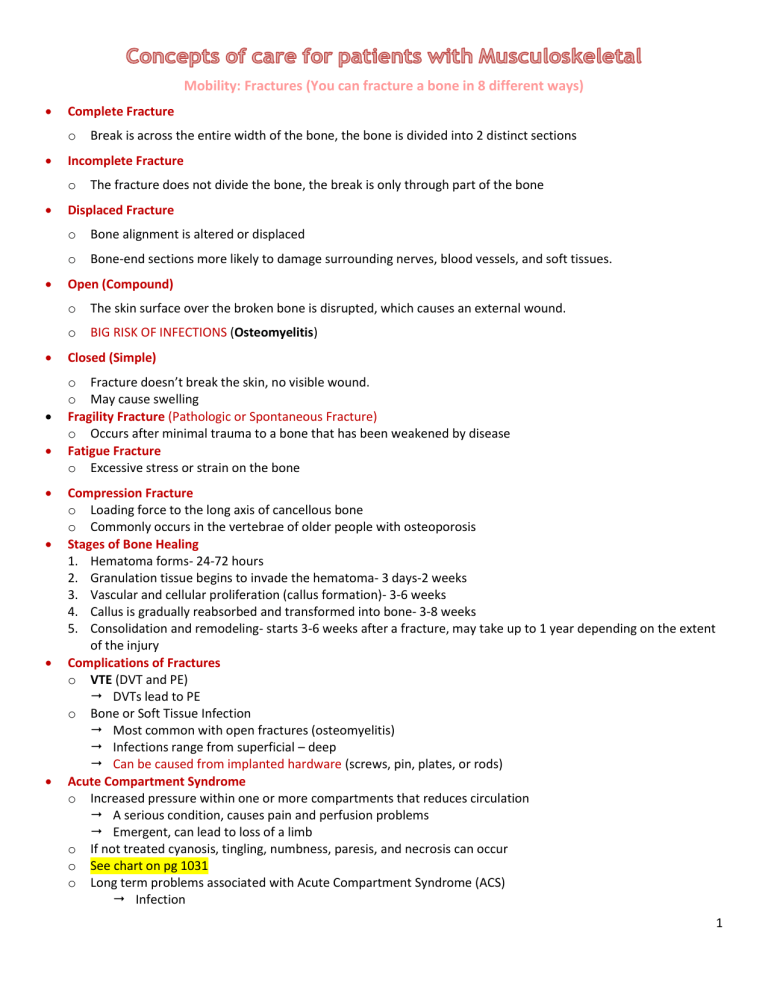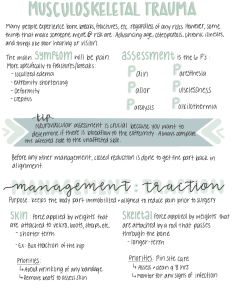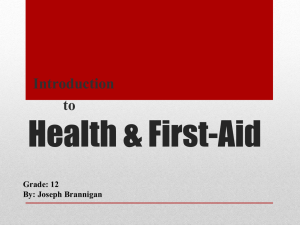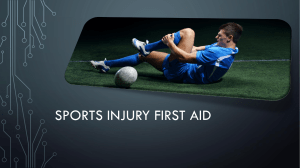
Mobility: Fractures (You can fracture a bone in 8 different ways) Complete Fracture o Incomplete Fracture o Break is across the entire width of the bone, the bone is divided into 2 distinct sections The fracture does not divide the bone, the break is only through part of the bone Displaced Fracture o Bone alignment is altered or displaced o Bone-end sections more likely to damage surrounding nerves, blood vessels, and soft tissues. Open (Compound) o The skin surface over the broken bone is disrupted, which causes an external wound. o BIG RISK OF INFECTIONS (Osteomyelitis) Closed (Simple) o Fracture doesn’t break the skin, no visible wound. o May cause swelling Fragility Fracture (Pathologic or Spontaneous Fracture) o Occurs after minimal trauma to a bone that has been weakened by disease Fatigue Fracture o Excessive stress or strain on the bone Compression Fracture o Loading force to the long axis of cancellous bone o Commonly occurs in the vertebrae of older people with osteoporosis Stages of Bone Healing 1. Hematoma forms- 24-72 hours 2. Granulation tissue begins to invade the hematoma- 3 days-2 weeks 3. Vascular and cellular proliferation (callus formation)- 3-6 weeks 4. Callus is gradually reabsorbed and transformed into bone- 3-8 weeks 5. Consolidation and remodeling- starts 3-6 weeks after a fracture, may take up to 1 year depending on the extent of the injury Complications of Fractures o VTE (DVT and PE) DVTs lead to PE o Bone or Soft Tissue Infection Most common with open fractures (osteomyelitis) Infections range from superficial – deep Can be caused from implanted hardware (screws, pin, plates, or rods) Acute Compartment Syndrome o Increased pressure within one or more compartments that reduces circulation A serious condition, causes pain and perfusion problems Emergent, can lead to loss of a limb o If not treated cyanosis, tingling, numbness, paresis, and necrosis can occur o See chart on pg 1031 o Long term problems associated with Acute Compartment Syndrome (ACS) Infection 1 Persistent motor weakness in the affected limb Contracture Myoglobinuric Renal Failure (Excess myoglobin in urine from muscle breakdown) Fat Embolism Syndrome o Fat globules are released from the yellow bone marrow into the blood stream 12-48 hours after injury. o Early S/S: hypoxemia, dyspnea, and tachypnea o Late S/S: Headache, lethargy, agitation, confusion, decreased level of consciousness, seizures, and vision changes o Abnormal findings include: Decreased Pao2 level (below 60 mm Hg) Increased Erythrocyte Sedimentation Rate (ESR) aka test for inflammation Decreased Serum Calcium Levels Decreased RBC and Platelet Count Increased Serum Lipid Levels o Treatment Bedrest, Gentle Handling, Oxygen, Hydration (Iv Fluids), Possible Steroid Therapy, Fracture Immobilization. Chronic Complications of fractures o Avascular Necrosis: decreased perfusion, leads to bone and tissue death. Most associated with hip fractures High risk for patients on long term corticosteroid use o Delayed union: bone that has not healed within 6 months but ends up healing completely Malunion: heals incorrectly, does not fully align Nonunion: never completely heals If bone doesn’t heal, the pt may have persistent pain and decreased mobility form deformity. Complex Regional Pain Syndrome (CRPS) o Pain that can’t be relieved o Genetic factors play a role in CRPS o Commonly occurs in feet and hands o Symptoms: Abnormalities of the Autonomic Nervous System a) Changes in Color, Temp, Excessive Sweating, Edema, and Skin Sensitivity Motor Symptoms b) Paresis, muscle spasms, loss of function Altered Sensory Perception c) Intense burning pain (Doesn’t stop) Health Promotion and Maintenance Teach Patients: o Osteoporosis Screening o Fall Prevention o Home Safety o Dangers of substance use + driving o Helmet Use Patient History: o Determine Cause of Fracture o Events Leading up to Injury o Substance Use (especially opioids + alcohol) o Occupational and Recreational Activities Physical Assessment S/S o Check for Trauma + Other Body Systems o Life Threatening 1st 2 o Pelvic Fractures: Assess vital signs, skin color, + altered level of consciousness for possible hypovolemic shock from blood loss. One Pelvic Fracture = Usually Another Pelvic Fracture (hairline) Check for urine in the blood Check for voiding difficulties (could have damaged the bladder or urethra) Pain (common for most fractures) o Pts. w/ fractured hip may have Groin Pain or Pain in Back Of Knee or Lower Back Shoulder or Upper Arm Fracture o Have patient sit or stand, look for drooping or other abnormal positioning o For more distal areas of the arm place the patient in supine position to reduce swelling Look for Changes in Bone Alignment Look for Extremity Shortening or Change in Bone Shape Bruising Psychosocial Assessment Self-explanatory Laboratory Assessment Hemoglobin (Decreased) Hematocrit (Usually low) Erythrocyte Sedimentation Rate (ESR-Inflammation Indicator) (Increased) WBC (Increased) Serum Calcium + Phosphorus Imaging Assessment X-rays CT (hip and pelvis) MRI (Soft tissue damage) Managing Acute Pain Interventions: • Emergency: o Call 911, ABCs, quick head to toe, and provide lifesaving care if needed o Remove clothing + jewelry (leave on shoes, removal can cause increased trauma) o Apply direct pressure if bleeding o Keep pt warm and supine position o Check neuro status o Immobilize by splinting o Cover open would (sterile if possible) Bone Reduction: (Open or Closed) o Closed Reduction (Nonsurgical) Manually pull the bone into realignment yikes Open Reduction (Surgical) o Internal Fixation: screws, pins, plates, or rods o External Fixation: pins + wires inserted thru skin Nonsurgical management o o Closed Reduction + Immobilization Splints + Orthopedic Boots/Shoes Keeps the bone in place during healing Allows for extremity swelling w/out causing decreased arterial perfusion 3 o o o o o o Casts Can apply after a reduction Allows early mobility and reduces pain Teach patient they should be able to insert 1 finger between the cast + the skin May have to be replaced if too much swelling Fiberglass Cast most common type of cast material Dry in minutes Decreases impaired tissue integrity Arm Cast: Elevate the arm above the heart to reduce swelling Ice first 24-48 hours May use Sling Plaster Casts: Take approx.. 24 hrs. to dry Traction: Using a pulling force to a part of the body To provide bone reduction Or as last resort to reduce muscle spasms Patients are often hospitalized. Traction (2 Main Types) 1. Skin Tractions: Uses Velcro Boot, or Halter Purpose: to reduce painful muscle spasms that happen w/ hip + proximal femur fractures 5–10-pound weights are used 2. Skeletal Tractions: Screws surgically implanted into bone Aids in bone realignment but impairs mobility 15–30-pound weights are used Action Alert Weights should NOT be removed w/out prescription Should not be lifted manually or allowed to rest on the floor Inspect skin every 8 hours Drug Therapy Opioids, Nonopioids, and NSIADS o Sever or multiple fractures: IV pump is used (Morphine, fentanyl, or hydromorphone o Oxycodone & Oxycodone w/ Acetaminophen or Hydrocodone w/ Acetaminophen are common oral drugs used For Severe Pain Opioid + Nonopioid Drugs (alternated or given together) to manage pain and peripherally at the injury site Constipation = Common w/ Opioid Use (especially in elderly) o Stool softeners o Encourage fluids, high-fiber diet, and activity as tolerated Physical Therapy: To Increase Mobility Use crutches, walkers, knee-walker scooter Prevent + Monitoring for Neurovascular Compromise o Perform neuro assessments often Monitor for the 6 P’s (ACS: Acute Compartment Syndrome) 1. Pain 2. Pressure 4 3. Paralysis 4. Paresthesia 5. Pallor 6. Pulselessness (rare or late stage) 7. Preventing Infection o Use aseptic technique for dressing changes and wound irrigation o Hand WASHING o Monitor VS every 4-8 hours after fracture bc increases in temp and pulse are often signs of infection Home Care Management Home Mobility Barriers o Stairs o Easy access to the bathroom o Small pets o Clutter o Floors (slippery or uneven) o Anything that increases fall risk o Make sure they know how to use walker, wheelchair, etc. Depending on Age + Condition -may need a rehab facility Self-Management Education Oral + Written Instructions (Assistive Devices + Meds) Wound Care at Home (promotes healing + prevents infection) Teach S/S to look for that Indicate Complications Encourage High Protein + Calcium Diets (for bone and tissue healing) Lower Extremity Fractures o Less weight bearing on long boned can cause anemia o Red bone marrow needs weigh bearing to stimulate RBC production o Encourage high iron food Take daily iron supplement Stool softener (for iron & opioids) Schedule Follow-Ups (important) Lower Extremity Fracturs Hip Fractures o Most Common in Older Adults (+ most frequent injury seen) Osteoporosis (biggest risk factor) High Mortality Rate Because: o Surgery complications o Depression o Decreased mobility Femoral Neck Fracture o Causes a disruption in the blood supply and can lead to avascular necrosis Most often fixed with a total hip arthroplasty Types of Hip Fractures: o Intertrochanteric o Subtrochanteric o Femoral neck o Sub-Capital o Capital 5 o o Intracapsular (within joint capsule) Extracapsular (outside joint capsule) Other Lower Extremity Fractures Major treatment is closed reduction with casting, internal fixation, and external fixation o Lower 2/3 of femur – usually from trauma o Tibia-Fibula o Ankle o Foot or Phalanges o Closed Reduction: Pt. might need cast for 6-10 wks o Soft Tissue Damage: External Fixation (6-10 weeks), followed by cast until healed Fractures of the Chest + Pelvis Rib or Sternum Fracture (Assess ABC) o Potential for puncture of the lungs, heart, or arteries by bone fragments o Lower rib fracture Can damage underlying organs (kidney, spleen, liver) o Generally heal on their own (w/out surgical intervention) High Risk for Pneumonia Pelvis Fracture (Vascular + close to major organs + blood vessels) o Pelvic fractures are the (2nd most common cause of death from trauma) o Assess for internal abdominal trauma Blood in Urine/Stool Abdominal Rigidity or Swelling Trauma team might use Peritoneal Lavage, CT Scan, or Ultrasound 2 Types of Pelvic Fractures 1. Non-Weight-Bearing: Pubic Rami or Iliac Crest Treatment: bedrest on a firm mattress or bed board 2. Weight-bearing: multiple fractures of the pelvic ring creating instability or a fractures acetabulum Treatment: external fixation or ORIF or both Recovery is based on person and extent of injury Compression Fractures of the Spine Most caused by Osteoporosis or Metastatic Bone Cancer Causes Severe pain (especially when moving) Deformity (kyphosis, etc.) Possible Neurological Damage Non-Surgical Management o Bedrest, analgesics, Nerve Blocks, & Pt (for muscle strength maintenance) Vertebroplasty: for Vertebral Compression Fractures (VCFs) that are painful + impair mobility o Minimally Invasive Technique (cement injected thru skin & directly into fracture) Provides stability and pain relief Teach s/s of infection Do not soak in bath for 1 week Use analgesics as needed Carpal Tunnel Syndrome Pathophysiology Overview o Median nerve in wrist gets compressed (causes pain + numbness) Usually in Dominant Hand but could be both o Repetitive Stress Injury (RSI) o History of Colles’ Fracture (fracture from catching yourself during a fall) 6 o Usually Chronic o Common Complication of Certain Metabolic + Connective Tissue Diseases Ergonomic Workstations (important) Assessment o Pain may be worse at night o Numbness + Paresthesia o Phalen’s Maneuver (used to diagnose carpal tunnel) Pt presses the back of hands + fingers together w/ wrists flexed + fingers pointed down Stay in position for 1-2 min. Causes numbness + tingling (aka paresthesia) w/in 60 seconds if u have carpal tunnel Interventions o Nonsurgical Management Drug therapy: NSIADS or sometimes corticosteroids Immobilization Splint or hand brace (day or night-sometimes both) o Surgical Management Nerve decompression Knee Injuries Trauma can cause cartilage, ligament, and tendon injury o “RICE” mnemonic Rest Ice Compression Elevate Rotator Cuff Injuries Occurs from a Fall, Throwing, or Heavy Lifting o Partial-Thickness Tear NSAIDs Intermittent steroid injections PT Activity limitations o Full-Thickness Tear Surgical Repair Post-Surgical: Rehab, Pendulum Exercises 7






